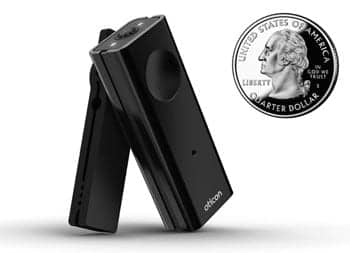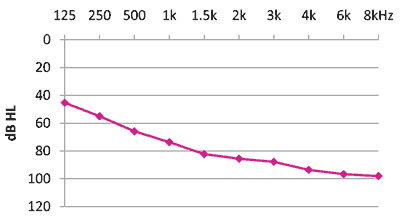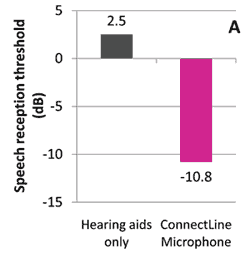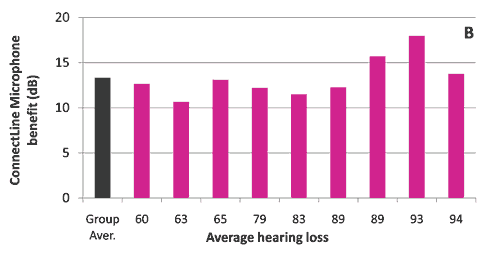Three significant benefits previously available only through FM systems—including reduced background noise, reverberation, and high SNR—are attained by a new wireless remote microphone from Oticon. The ConnectLine Microphone transmits wireless signals from virtually any sound source (within about 40 feet) directly into the Streamer, which then sends the audio signal to two wireless-enabled Oticon hearing aids.
Thomas Edison (1847-1931) said, “I never perfected an invention that I did not think about in terms of the service it might give others… I find out what the world needs, then I proceed to invent…”1 Thus, Edison created communication tools, allowing people to exchange information at a distance. As the world shifted from tethered/wired communication devices to wireless connectivity devices, the applicability of sound-delivering devices to our daily lives increased exponentially, as did the potential for humans to communicate with our fellow beings.2
In 2011, we depend and benefit more from personalized listening devices as we enrich and deepen our listening experience. Many of us can’t imagine getting through our daily routines without our cell phones and/or Bluetooth headsets. Hearing aid connectivity expands the opportunities available to hearing aid wearers by connecting their hearing aids to multiple communication products. In essence, advanced hearing instruments can perform similar to hands-free headsets. Indeed, in this regard, connectivity has already had a major impact on hearing health care; connectivity increases and simplifies human interaction through communication tools and protocols.2
Hearing Aids and Wireless Apps
Bloom3 noted, “We are living in a wireless world.” She reported Kochkin’s prediction that wireless connectivity is likely to lead to double-digit growth in hearing aid sales (“double the usefulness, double the sales”). Clearly, the potential to increase sales, utility, and user satisfaction via digital wireless features in hearing aids is vast.
Beck and Fabry4 described the myriad of connectivity tools available in modern listening devices including: induction loops and telecoils, infrared systems, Bluetooth Systems, FM, and dedicated wireless. With regard to the best system, they commented the best system is “the one that is used.”4 As connectivity systems become increasingly useful, smaller, more efficient, more applicable, and universal, they will continue to gain popularity and impact quality of life, user satisfaction, and hearing aid sales.
Indeed, for a connectivity solution to be actually used, it needs to be versatile enough to improve communication in many situations—bringing in both the “far world,”5 such as telephone calls via the cell phone or landline phone, and the near world, such as your significant other at a romantic dinner in a noisy restaurant. Further, for a connectivity solution to be used, it needs to be a “seamless” system, such that listening to TV would not exclude the wearer from their surroundings or make them miss an important telephone call.
The hearing aid user’s fear and perception of complexity is a barrier that needs to be addressed by professionals and manufacturers. Indeed, two areas previously identified as “most in need” of simple connectivity solutions are telephone and television wireless applications.6

FIGURE 1. The ConnectLine Microphone.
Selection in Microphone Use
In 2011, Oticon is introducing the ConnectLine Microphone (Figure 1). This device completes the connectivity circle by allowing people who use Oticon’s Streamer (v1.4 and newer) and other ConnectLine products—the ConnectLine TV Adapter and the Phone Adapter—to focus on a person or alternative sound source.
The ConnectLine Microphone is made specifically for people with moderate to severe-profound sensorineural hearing loss. The recommended listening environments, within which the ConnectLine Microphone potentially offers the most benefits, are among the most challenging listening situations: cocktail parties, noisy restaurants, lecture halls, automobiles, and other difficult listening situations in which distance and background noise present significant impediments to understanding speech.
In brief, the ConnectLine Microphone is wireless, portable, and small—a little less than 1 by 2 inches and just over one-half-inch wide. The device transmits a wireless signal from virtually any sound source (within approximately 40 feet) directly into the Streamer, which then sends the audio signal to two wireless-enabled Oticon hearing aids.
The microphone is fully integrated in the ConnectLine family. While using the ConnectLine system, the person wearing the Streamer simply presses a button to control which sound system to attend to the ConnectLine TV Adapter, Phone Adapter, or Microphone.
Benefits of wireless remote microphone. Although detailed specifications are beyond the scope of this article, the ConnectLine Microphone offers three combined significant benefits previously available only through FM systems7:
1) Reduction of background noise;
2) Reduction of reverberation; and
3) Maintenance of the signal-to-noise ratio (SNR) as measured at the sound source (ie, the person talking).
The ConnectLine Microphone features an advanced noise reduction algorithm based on the input signal from the two microphone ports located on the microphone casing. The primary microphone port is located on top (closest to the speaker’s mouth) and the secondary microphone port is located near the bottom on the front panel. Using the signals from both microphones, extraneous noise is identified and attenuated from the total signal sent to the Streamer. Thus, the ConnectLine Microphone not only maintains a favorable SNR ratio given the proximity to the sound source, but potentially further enhances the SNR in many noisy acoustic situations.
Versatile and efficient. The ConnectLine Microphone can be attached to clothing via multiple options (clip or lanyard) and can be handheld (for example, at a restaurant, the wearer may give the ConnectLine Microphone to the waiter/waitress¨for a brief conversation). The ConnectLine Microphone weighs 13 grams (approximately 3/100ths of a pound), and it comes with a 5 volt power supply to charge/recharge the battery. The battery requires approximately 90 minutes to fully charge and typically supplies between 5 and 6 hours of talk time. The ConnectLine Microphone features “auto-shut-off” after 30 minutes of non-use.
Microphone Field Test Results

FIGURE 2. Average hearing loss of the 9 participants in this study.
A prototype of the ConnectLine Microphone was tested by 9 experienced hearing aid wearers at Oticon’s headquarters in Smørum, Denmark. Participants used their own hearing aids, which included Oticon’s Chili Super Power, Agil, and Epoq instruments in various styles (BTE, BTE Power, RITE, and RITE Power). The average hearing loss of the participants is shown in Figure 2.
Speech intelligibility was evaluated in a modified laboratory setup, similar to a previously described protocol to evaluate FM equipment.8 In brief, speech was presented from a manikin at 0° azimuth within a circle of four loudspeakers with a radius of 4.6 feet (1.4 meters). Unmodulated speech-shaped noise was presented from ±30° and ±110° azimuth. An adaptive procedure was employed in tandem with the Dantale II speech test9 to determine the speech reception threshold (SRT), which permitted correct identification of 70% of the words presented. The two listening conditions were:
1) Hearing instruments (only) in full-directional program, and
2) Hearing instruments connected to the ConnectLine Microphone using the corresponding default hearing instrument settings.
The ConnectLine Microphone was placed about 7 inches (17.5 cm) below the mouth of the manikin to approximate typical usage of the microphone.
Results from the speech intelligibility test are presented in Figure 3a. The left panel represents the average speech reception threshold of all participants while wearing binaural amplification (grey bar) and while wearing binaural amplification with the ConnectLine Microphone (magenta bar) engaged. To achieve a 70% correct identification of the Dantale II speech stimuli, a SNR of +2.5 dB was required with binaural amplification. However, while wearing binaural amplification in tandem with the ConnectLine Microphone, the SNR required to achieve the same performance level (70% correct identification) was decreased to -10.8 dB.

FIGURE 3A. The average speech reception thresholds of all nine participants.

FIGURE 3B. Average and individual benefit of using the ConnectLine Microphone compared to hearing aids in a directional program.
This dramatic improvement of more than 13 dB indicates that, when the ConnectLine Microphone is engaged, “FM-like” performance (with respect to SNR) may be expected. Despite a noisy and difficult listening environment, the wireless path from the ConnectLine Microphone to the listener’s ear is much less degraded by the impact of environmental acoustics and background noise than are traditional microphones, which are dependent on air conduction sound transmission.
In Figure 3b, which shows individual subject results, the subjects are presented in the order of their four-frequency (500, 1000, 2000, 4000 Hz) puretone average (ie, subjects are ordered with progressively higher levels of hearing loss, from left to right). Of note, each participant gained at least 10 dB benefit with regard to this measure of SNR while using their hearing aids with the ConnectLine Microphone, compared to their hearing aids with the directional program engaged.
Summary
Oticon’s new ConnectLine Microphone completes the connectivity circle initiated via Streamer in tandem with ConnectLine TV Adapter and ConnectLine Phone Adapter. The new microphone provides advanced wireless connectivity to any sound source through a small, lightweight, portable, battery-powered device. It shares advanced features with FM systems, such as maintaining a maximal SNR while potentially reducing reverberation and background noise due to the proximity of the microphone to the sound source and the advanced dual-microphone noise reduction system.
The pilot-test results presented above demonstrate improved SNRs (≥10 dB for each participant), thus improving intelligibility in difficult listening situations for participants with moderate-to-severe-to-profound sensorineural hearing loss. ConnectLine Microphone presents a useful, efficient, and highly portable listening solution for difficult listening environments for people with significant hearing loss.
References
- Endres F. Connectivity through sound: a brief history of captioned phones. Hearing Review. 2010;17(3):68-69. Accessed February 4, 20111.
- Beck DL, Harvey MA. Traditional and nontraditional communication and connectivity. Hearing Review. 2009;16(1):30-33. Accessed February 4, 2011.
- Bloom S. Connectivity—Early steps point the way toward wireless wonders to come. Hear Jour. 2009;62(10):17-20.
- Beck DL, Fabry D. Access America–It’s about connectivity. Audiology Today. January/February 2011:24-29.
- Lindley G. Accessing the “far world”: a new age of connectivity for hearing aids. Hearing Review. 2007;14(5):54-59. Accessed February 4, 2011.
- Groth J, Anthonsen F. Fewer wires, less complexity, and more connections: the new challenge for wireless hearing instruments. Hearing Review. 2010;17(6):28-36. Accessed February 4, 2011.
- Beck DL, Doty-Tomasula M, Sexton J. FM made friendly. Posted August 28, 2006. Available at: www.audiologyonline.com/articles/article_detail.asp?article_id=1688. Accessed February 4, 2011.
- Thibodeau L. Benefits of adaptive FM systems on speech recognition in noise for listeners who use hearing aids. Am J Audiol. 2010;19:36-45.
- Wagener K, Josvassen JL, Ardenkjær R. Design, optimization and evaluation of a Danish sentence test in noise. Int J Audiol. 2003;42:10-17.
Citation for this article:
Beck DL, Holmberg M. Connectivity in 2011: Enhancing the human experience. Hearing Review. 2011;18(3):38,69-70.






